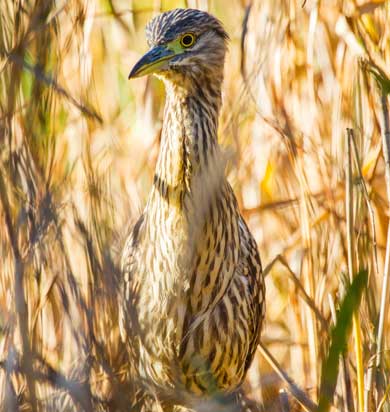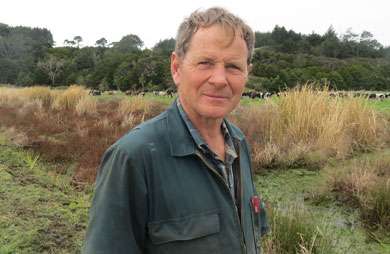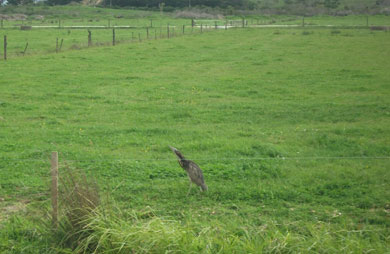Archived content: This media release was accurate on the date of publication.
Date: 14 July 2016
When Ian Lupton bought his farm - 8 km north of Dargaville – he saw no native wildlife on the property. This changed after he reduced the amount of nitrogen fertiliser and chemical spray being applied on the farm.
“Within three years frogs, eels, pheasants, and herons were common daily sightings. I even began seeing bittern fishing for eels in a canal and drainage ditches on the farm,” said Ian Lupton.

Australasian bittern/matuku
Image: Craig Bullock ©
Australasian bitterns, or matuku, are an endangered native bird that lives in wetland areas. The brown, heron sized birds, are very shy and have excellent camouflage. They feed mainly at night, on fish, eels, frogs, freshwater crayfish or koura and aquatic insects.
“Regularly seeing bitterns on my farm gave me the idea of establishing a bittern sanctuary because a successful dairy farm and native wildlife can go hand in hand,” said Ian Lupton.
The Living Water partnership is a ten year partnership between Fonterra and DOC who are working with dairy farmers, iwi, conservation groups, schools and other agencies in five key catchments in significant dairying regions. The focus is on increasing ecosystem resilience and farm profitability, which includes improving water quality and increasing the abundance and variety of native wildife in the catchments.
In Northland, Living Water is working in the Hikurangi catchment that feeds into the Kaipara Harbour. With help from Northland Regional Council, Ian Lupton sought funding from Living Water for his bittern project.
Living Water is contributing funding to the project. Fonterra North Island Project Manager Tim Brandenburg said, “Ian’s dream of creating a sanctuary for bitterns fits perfectly with Living Water’s goal to increase the variety and abundance of native wildlife in our catchments.
“The first step in building the sanctuary, is finding out how many bitterns are living on the farm,” said DOC Ranger Olly Knox, who is co-ordinating the sanctuary work.
“Male bitterns make a booming sound, with each male making its own distinctive sequence of booms. Living Water funding will be used to buy digital recorders to record the bitterns booming on Ian’s farm. The recordings will be analysed to establish the number of bitterns on the property,” said Olly Knox.
The funding will enable Ian Lupton to control stoats and feral cats on his farm. These predators eat bitterns eggs and chicks. It will also be used to control weeds that smother native plants and trees. Enabling native vegetation to flourish on the farm will increase the habitat for the bitterns.

Fonterra farmer Ian Lupton at his farm's bittern sanctuary
Image: Nick Hirst | DOC

A bittern on Ian Lupton's farm
Image: Ian Lupton ©
Living Water is also buying native plants and grasses to plant on the banks of the canal and drainage ditches on the farm. This riparian planting will create more bittern habitat, which will encourage more breeding by the birds on the farm.
“Riparian planting also improves water quality by reducing the runoff of sediment and nutrients into the canal and drainage ditches. And it provides habitat for the fish, eels, frogs and aquatic insects in the waterways. Having more of these freshwater species will increase the bittern’s food supply,” said Olly Knox.
Dargaville High School is supplying native trees, flax and grasses for the riparian planting. Enviroschools Northland secondary schools facilitator, Jacque Knight, worked with teacher Tim Pratt to establish the nursery. Jacque has also involved Dargaville High students in the bittern project.
“The students are making monthly visits to the farm to record sightings of bitterns, noting details of the vegetation and conditions they favour,” said Jacque Knight. “These are secretive birds. If we can learn more about the habitat and conditions they like, we can recreate these as we build the sanctuary.”
Local iwi, Te Roroa, is supporting the establishment of the sanctuary as it will enhance the local habitat and contribute to a healthy environment for the Matuku.
Northland Regional Council Land management adviser, Pete Graham, is working with Ian Lupton to implement a Farm Water Quality Improvement Plan on his farm. “Creating the bitten sanctuary meshes really well with our water quality improvement plan. The riparian planting improves water quality and creates habitat for bittern.”
Contact
Anna Johnstone, Fonterra Communications
Phone: +64 21 458 831 / 24 hour media line: +64 21 507 072
For media enquiries contact:
Email: media@doc.govt.nz